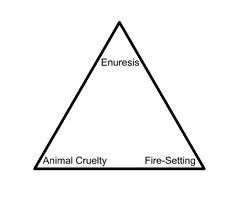|
Welcome
to Serial Killers 101. This class will focus on the roots of psychosis
and some generally agreed-upon traits common among serial killers.
Psychosis truly does have its
roots in childhood. I spent a lot of time this month watching
documentaries on YouTube about serial killers, and this fact is
glaringly in common with all of them.
Further research led to me the
concept of the Macdonald Triad, which is also known as the Triad of
Psychopathy (pronounced sigh-KOP-athy for those who like to say it the
other way!). It’s named for J.M. Macdonald, a forensic psychiatrist who
wrote “The Threat to Kill” in 1963, a paper that appeared in the American
Journal of Psychiatry.
 In
this paper, he detailed a set of three behavioral characteristics he
claimed that if they were present together in a person, they would be
associated with later violent tendencies. It should be noted that
Macdonald focused on hospitalized patients who had threatened to kill,
not patients who had actually killed. The patients who had threatened
the most violence often did have these three traits in their
background. Other studies have found statistical significance to the
triad, and some studies have not. In
this paper, he detailed a set of three behavioral characteristics he
claimed that if they were present together in a person, they would be
associated with later violent tendencies. It should be noted that
Macdonald focused on hospitalized patients who had threatened to kill,
not patients who had actually killed. The patients who had threatened
the most violence often did have these three traits in their
background. Other studies have found statistical significance to the
triad, and some studies have not.
The traits, in no particular
order, are:
1) Bed Wetting
Macdonald found that bed wetting
past the age of five to be significant. Two psychiatrists (Hellman and
Blackman) claimed that enuresis―the act of voiding urine while
asleep―was a form of sadism or hostility, because it “in fantasy was
equated with damaging and destroying.”
Research
had subsequently discounted associating bed wetting with violent
tendencies but makes the point that bed wetting past the age of five
can be humiliating for the child, depending on how the child is treated
by parental figures for the act. If belittled or treated cruelly, the
child might then be more inclined to engage in the other aspects of the
triad as an outlet for their frustration.
2) Animal Cruelty
|
Torturing
animals can be seen as
a precursor or rehearsal for killing humans. Torturing any animal is
bad, but messing with dogs and cats is particularly so, because they
are seen as more humanlike due to being pets. Toads, turtles, worms,
and the like are less like pets and killing or torturing them doesn’t
violate that connection between humans and pets as much.
Some psychopaths engage in
animal cruelty as a way to vent frustrations, since in childhood the
child could not retaliate toward those who humiliated them. So they
selected vulnerable animals, seeing them as weaker . . . its future
victim selection at a young age. Studies prove that killers who engaged
in animal cruelty often used the same method on their victims.
3) Fire Setting
Fire setting is seen as a less
severe or “first shot” at releasing aggression. Since extensive
humiliation is found in the backgrounds of many serial killers, it’s
theorized that setting fire and venting frustration and anger by doing
so helps return the child to a normal state of self-worth.
It doesn’t have to be huge fires
to be an outlet for aggression. Trash cans, small flame throwers,
homemade “bombs”―they all serve their purpose, just as setting fire to
a building or car does.
Join me next month for the
advanced level class, Serial Killers 201, where we will look at the
types of serial killers.


|